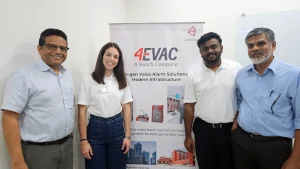In today’s rapidly converging digital landscape, the once clear boundaries between Information and Communication Technology (ICT) and Audio-Visual (AV) systems are fading fast. With the rise of IP-based AV solutions, cloud collaboration platforms, and the increasing demand for smart, connected environments, many ICT system integrators are eyeing the AV industry as a natural next step in their evolution.
But is it a seamless transition? While the integration of ICT and AV presents clear strategic advantages, it also comes with a unique set of challenges that can’t be overlooked.
AV is no longer just projectors and speakers. Today’s landscape encompasses digital signage, unified communication platforms, immersive experience rooms, hybrid meeting spaces, and smart building control systems. As organizations invest heavily in collaboration technologies and digital experiences, ICT integrators see a growing market ripe for expansion and diversification of revenue streams. This evolution represents a fundamental shift in how we perceive audiovisual technology, transforming it from a simple presentation tool into a comprehensive ecosystem of connected experiences.
The foundation of modern AV systems is built on the backbone of IT infrastructure. AV over IP, networked audio, remote device management, and cloud-based control platforms all speak the familiar language of ICT professionals. This technological convergence significantly lowers the entry barrier for ICT firms, who already possess deep expertise in networking, infrastructure, and cybersecurity—all critical components in contemporary AV deployments. The shared technical DNA between these disciplines creates a natural bridge for expansion.
ICT firms often enjoy long-standing trust and established relationships with enterprise clients. Adding AV services to their portfolio allows these companies to offer more holistic, turnkey solutions that span from structured cabling to networking, from security systems to digital collaboration platforms—all delivered under one roof. This comprehensive approach not only strengthens existing partnerships but also increases the lifetime value of each client relationship.
As digital transformation projects continue to grow in scope and complexity, clients are increasingly seeking single-vendor solutions to simplify procurement processes, reduce coordination complexity, and ensure clear accountability. An ICT integrator who also delivers professional AV services becomes a true one-stop shop—a powerful differentiator in an increasingly crowded marketplace. This positioning allows companies to command premium pricing while reducing competitive pressure.
The Challenges
Despite the apparent synergies, AV remains a highly specialized discipline where success hinges on a unique blend of technical expertise and design artistry. The transition isn’t as straightforward as many ICT professionals initially assume.
While ICT teams excel in IP networks, virtualization, and system security, AV systems demand expertise in acoustics, display calibration, signal flow, DSP programming, and human-centered UI/UX design. Without proper training and industry certifications such as AVIXA’s CTS or vendor-specific programs – ICT firms risk delivering subpar AV experiences that fail to meet client expectations and damage their reputation in this new market segment.
Acoustics, in particular, represents one of the most commonly overlooked aspects, not only by ICT integrators but even by some AV professionals. Yet it is absolutely foundational to achieving high-quality audio performance. Poor room acoustics cannot be “fixed” by hardware alone, regardless of how advanced the microphones, speakers, or digital signal processors may be. Reverberation, echo, and ambient noise drastically affect speech intelligibility and overall meeting effectiveness. Unfortunately, acoustics is often ignored in favor of more visible or seemingly technical components, leading to disappointing results despite significant investment in premium equipment.
The reality is that being an AV or ICT integrator or consultant does not automatically mean that acoustics is well understood. This specialized subject requires dedicated concentration and expertise to build truly exceptional user experiences.
AV projects operate within a fundamentally different ecosystem compared to traditional ICT deployments. These projects often intersect with architecture, interior design, construction timelines, and human factors engineering. This complex environment operates quite differently from the more modular, remote-friendly nature of typical ICT implementations. AV installations require significantly more on-site presence, coordination with various trades and contractors, and a deep understanding of physical space constraints and opportunities.
Post-deployment support for AV systems is inherently hands-on and user-facing, involving device calibration, control system updates, programming modifications, firmware management, and on-site troubleshooting. These requirements represent areas where traditional ICT support teams may lack both the necessary expertise and bandwidth to deliver the level of service that AV clients expect and demand.
A Roadmap for Success
For ICT system integrators looking to successfully enter the AV space, success lies in making strategic investments and embracing cultural adaptation. The path forward requires careful planning and execution across several key areas.
Investing in talent represents the most critical success factor. Companies must either hire experienced AV designers, engineers, and field technicians, or commit to comprehensive upskilling of existing staff. This includes encouraging CTS certifications and ongoing professional development to ensure teams stay current with rapidly evolving technologies and best practices.
Starting with hybrid projects provides a natural entry point by focusing on converged domains like video conferencing solutions (Zoom Rooms, Microsoft Teams Rooms), digital signage over IP networks, or unified communications platforms where ICT and AV expertise naturally intersect. These projects allow teams to build confidence and capabilities while working within familiar technological frameworks.
Building strategic vendor alliances with AV manufacturers and distributors provides access to essential training programs, design support resources, and competitive pricing structures that are crucial for project success and profitability. These relationships also provide ongoing technical support and product roadmap insights.
Adopting an AV design mindset requires embracing the human element that distinguishes AV from traditional ICT work. AV is not just about technical functionality—it’s fundamentally about creating experiences, ensuring usability, and facilitating meaningful human interaction. This mindset shift often represents the most challenging aspect of the transition for technically-oriented ICT professionals.
Piloting before scaling offers a prudent approach by considering subcontracting or co-delivering initial AV projects with established AV partners before building full in-house capabilities. This strategy reduces risk while providing valuable learning opportunities and market insights.
Conclusion
The convergence of AV and ICT isn’t merely a passing trend it represents the future of integrated technology environments. For ICT integrators, stepping into the AV space opens exciting new doors and revenue opportunities, but it also demands genuine respect for the craft, culture, and inherent complexity of professional AV integration.
Having personally handled both ICT and AV projects throughout my career, I can confidently say that while the technical foundations may overlap significantly, the approach, execution methodology, and client expectations are vastly different. AV is not simply a subset of IT it’s a distinct discipline with its own standards, practices, and success metrics.
Those organizations that commit to bridging the knowledge gap, align their processes with established AV best practices, and prioritize experience-driven design will not only survive this challenging transition—they will emerge as leaders in the integrated technology landscape. The future belongs to those who can seamlessly blend the reliability and security of ICT with the experiential richness of professional audiovisual systems.





